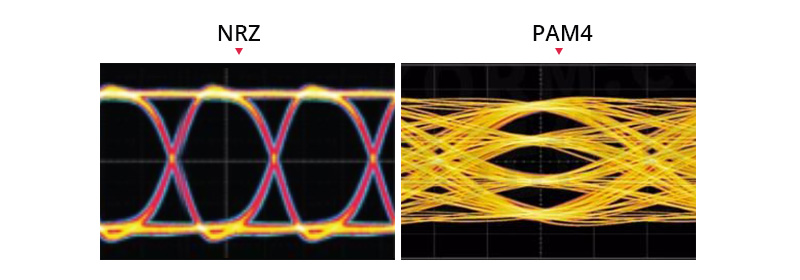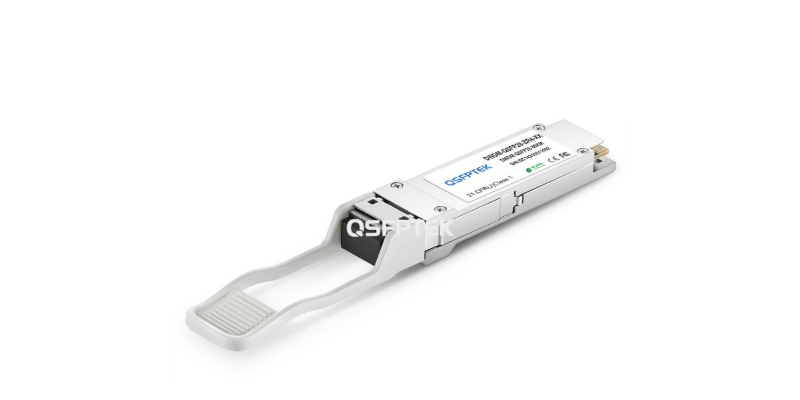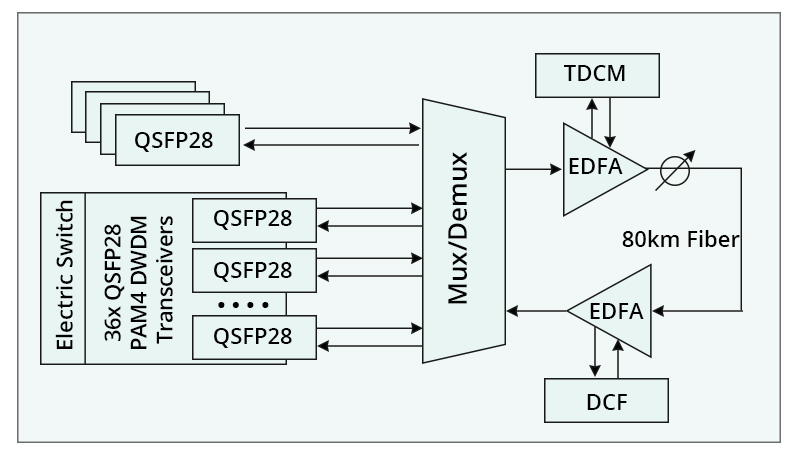QSFPTEK 100G QSFP28 PAM4 DWDM Transceiver Introduction
What Is PAM4? Why Do We Need PAM4?
The full name of PAM4 is Pulse-Amplitude Modulation 4-Level. As a high-order modulation technology, PAM4 has been recognized as a new generation data interconnection solution with features of low power consumption, low space occupation, and direct detection.
Why do we need PAM4? With the rapid development of big data, cloud computing, and artificial intelligence, traditional data center interconnection bandwidth is not able to fulfill the requirements of current data transmission. The introduction of PAM4 technology is to solve the contradiction between the increasing bandwidth requirements and the limited number of actual physical channels. Today, PAM4 has been used in the standard of several high-speed 50G/100G/200G/400G optical transceivers. And it can be predicted that PAM4 modulation will become an important technical direction in the 5G network.
NRZ vs PSM4
NRZ (Non-Return-to-Zero) code is a standard data transmission format, widely applied in short distance 100G optical transceivers. NRZ modulated signal has only two levels while PAM4 code has four levels, so PAM4 code can be considered as a superposition of two NRZ codes. For NRZ, each symbol transmits 1 bit of data. As for PAM4, each symbol transmits 2 bits of data. Therefore, the PAM4 code is able to transmit twice as much data as the NRZ code at the same baud rate.
However, there are also challenges to the application of PAM4 technology. Low SNR (Signal-to-Noise Ratio) is one of the challenges. From the eye diagram of NRZ and PAM4, it can be found that the PAM4 has three complicated eye diagrams and the eye height is a third of the NRZ, which results in PAM4 being more sensitive to amplitude noise and having a relatively higher BER (Bit Error Rate) than NRZ. Therefore, the FEC ( Forward Error Correction) function is adopted to decrease the BER and improve the SNR.
Signal Specification: NRZ vs PSM4

NRZ Code Format vs PSM4 Code Format

Eye Diagram: NRZ vs PAM4
QSFP28 PAM4 DWDM Transceiver Introduction

QSFPTEK QSFP28 PAM4 DWDM Transceiver
The manufacture of the 100G QSFP28 PAM4 DWDM transceiver is based on a highly integrated silicon photonic chip. The transmitting part of the chip has a pair of integrated waveguide M-Z optical modulators, and the receiving part has a pair of photodetectors. Both of the optical modulators and photodetectors are 25Gbps bandwidth. The transmitted signals are multiplexing and demultiplexing over MUX and Demux.
Adopting silicon photonics technology, a PAM4 ASIC (Application Specific Integrated Circuit ) with the characteristics of a double carrier is developed and encapsulated in the QSFP28 optical module, thus the 100G DWDM PAM4 QSFP28 optical module possesses the capacity of digital signal processing and FEC ( Forward Error Correction).
When applied in the data center interconnection system and DWDM ( Dense Wavelength Division Multiplexing) system, 100G PAM4 transceiver supports the data transmission rate up to 4Tb/s for each fiber and allows multiple data centers to interconnect each other at a distance up to 80km and act as a single data center. Meanwhile, the power consumption is controlled at 4.5W.
QSFPTEK QSFP28 PAM4 DWDM Transceiver Testing Program
Inphi Corporation firstly introduced the 100G QSFP28 PAM4 DWDM transceiver. Now QSFPTEK has developed a proprietary mature production and testing system for QSFP28 PAM4 DWDM transceivers. QSFPTEK sets up a complete QSFP28 PAM4 DWDM data transmission system and verified QSFPTEK QSFP28 PAM4 DWDM transceivers are able to support 4Tb/s data rate at link length up to 80km. The test results show the tolerance of the system to key obstacles including dispersion and fiber nonlinear effects and verified the system is reliable.

QSFPTEK PSM4 Testing Connecting System
QSFPTEK 100G QSFP28 DWDM PAM4 Transceiver Specification
- PAM4 technology (Color Z)
- Hot-pluggable QSFP28 form factor supporting 100G Ethernet
- Supports 4Tb/s capacity over a single fiber
- Up to 80km reach for G.652 SMF with transport white box
- 5W Max power consumption
- 100GHz ITU DWDM wavelength grid compatible
- Transmitter: Cooled EML 2*27.5Gbaud/s DWDM TOSA
- Receiver: 2*27.5Gbaud/s Pin-PD ROSA
- 4*25G CAUI4 electrical interface
- Integrated SFEC with high coding gain
- Dual CS adaptor
- Temperature range 0 to 70°C
Product List
The QSFPTEK family of high bandwidth density 100G QSFP28/400G QSFP-DD optical transceivers provide the industry’s most cost-effective solution for data centers, high-performance computing networks, enterprise networks, and service provider applications. Welcome to consult via [email protected].
You Might Like:
The Things You Should Know About 100G QSFP28
Common and Distinct Features of 100G LR4, CWDM4 and PSM4












